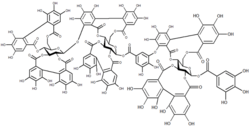Macromolecule facts for kids

Raspberry ellagitannin, a tannin composed of core of glucose units surrounded by gallic acid esters and ellagic acid units
A macromolecule is a molecule with a large number of atoms. The word is usually used only when describing polymers, molecules which are made up of smaller molecules called monomers. All organic monomers are based on carbon, usually with hydrogen, oxygen and nitrogen. There are inorganic macromolecules based on other monomers.
Examples:
- Proteins, composed of amino acids.
- Nucleic acids.
- DNA, composed of nucleotides.
- Carbohydrates, composed of monosaccharide sugars.
- Lipids or fats composed of fatty acids and triglycerides.
- Nylon, composed of polyamides.
- Polythiazyl, composed of polymeric sulphur nitride (SN)x.
Images for kids
-
Chemical structure of a polypeptide macromolecule
See also
 In Spanish: Macromolécula para niños
In Spanish: Macromolécula para niños

All content from Kiddle encyclopedia articles (including the article images and facts) can be freely used under Attribution-ShareAlike license, unless stated otherwise. Cite this article:
Macromolecule Facts for Kids. Kiddle Encyclopedia.

